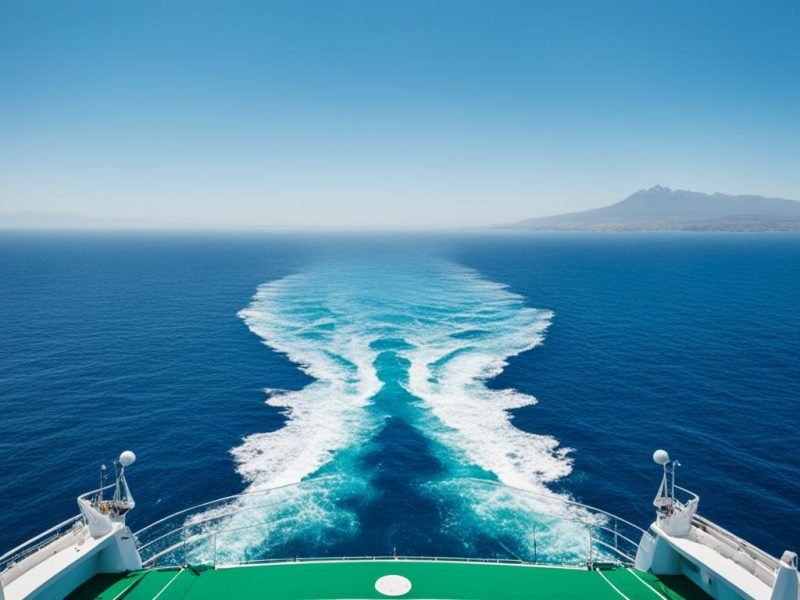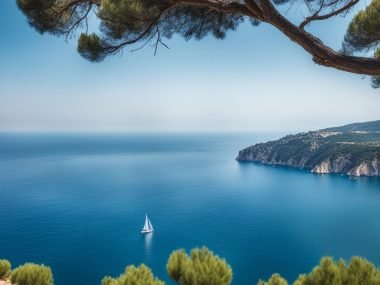Defying the vast expanse of the Mediterranean Sea that separates Southern Europe from its neighbor across the water, there are whispers of a place in Sicily where the silhouette of Tunisia might just be discernible. This rumor stirs the curiosity of travel enthusiasts and geographers alike, who are keenly aware of the geographic proximity of these two travel destinations.
While the distance between Tunisia and Sicily is only roughly 155 kilometers or 96 miles, the idea of actually viewing one from the other captivates the imagination, inviting questions about the possible interplay of landscapes at this crossroads of civilizations. Situated at a pivotal meeting point in the Mediterranean Sea, these two regions boast rich cultural heritages and scenic viewpoints that have enamored travelers for generations.
The delimiter of this geographic proximity is the Strait of Sicily, a swath of sea channeling currents and ferrying stories between the Tunisian shores and the cliffs of Sicily. The waters whisper tales of ancient travel routes and contemporary passages, making the strait not only a significant geographical feature but also a metaphorical bridge linking Southern Europe to the gates of North Africa.
Key Takeaways
- The Strait of Sicily is less than 100 miles wide, fostering curiosity about the visible proximity between Tunisia and Sicily.
- Both Tunisia and Sicily are popular travel destinations in the Mediterranean with a rich interwoven history.
- Sicily’s viewpoints offer more than just scenic beauty; they serve as potential vantage points for sighting Tunisian shores.
- The Mediterranean Sea is a fundamental geographical feature that unites and separates the two locations.
- The possibility of seeing Tunisia from Sicily underlines the intrigue and romance of travel within this historic part of the world.
Exploring the Geographical Proximity Between Sicily and Tunisia
Unveiling the intimate relationship shared between Sicily and Tunisia sheds light on a centuries-old link that has magnified their presence as focal travel destinations in the heart of Mediterranean Sea. The allure of geographic proximity tantalizes cartographers and wanderlust seekers alike, bridging the gap between the bustling bazaars of Northern Africa and the tranquility of Southern Europe.
Approximately 155 kilometers of the cerulean expanse, known as the Strait of Sicily, separates the regions, forming a historic conduit for cultural exchanges and voyages across different epochs. Historically, this strait has not only been a patrolled maritime crossroad for ancient empires but continues to serve as an essential trade and travel route today. Ferries frequently traverse this stretch, symbolizing the confluence of diversity and unity between these two geographically proximate lands.
From the rich tapestry of Carthaginian history to the enduring tales of the Odyssey, the Strait of Sicily has always been more than just a geographic entity—it’s a testament to the shared histories of Tunisia and Sicily.
- Profound historical connections between Southern Europe and Northern Africa
- Maritime routes enhancing economic and social interactions
- The Strait of Sicily as a vibrant tourist experience and travel destination
Travelers take heed: to embark on a journey from the windswept shores of Sicily to the sun-drenched landscapes of Tunisia is to follow in the wakes of countless adventurers. Be it for leisure or scholarly pursuit, the geographical proximity of these territories acts as a fascinating springboard for exploration into the past, present, and future of the Mediterranean crossroads.
Visibility Factors: Can You See Tunisia From Sicily?
The enthralling possibility of sighting Tunisian shores from the Sicilian coastline captures the imagination of intrepid travelers and curious observers alike. However, the reality of such a feat is governed by several crucial parameters. From the play of Climatic Conditions to the inevitable Topographical Obstacles and the most Optimal Viewing Times, a myriad of factors come together to dictate the likelihood of this cross-Mediterranean gaze.
Climatic Conditions Affecting Visibility
To catch a glimpse of the Tunisian shore from Sicily’s coastal expanse, one’s prospects are highly dependent on prevailing climatic conditions. Clear skies free from the haze of humidity are imperative for enhancing Visibility Factors. Atmospheric clarity must be coupled with minimal light pollution to fortify the odds of sighting the distant landmass. It’s not just a matter of luck; it’s the alignment of meteorological precision.
Topographical Obstacles and Line of Sight
The geographical embrace between Sicily and Tunisia is no trivial distance, at a stretch of approximately 96 miles. This is where Topographical Obstacles play their notable role. Even from the most advantageous Sicilian Shores, one must account for the Earth’s curvature along with any land elevation that could block the Line of Sight. These geographical sentinels stand guard, shaping the panoramic potential between these two points.
Optimal Viewing Times and Seasons
When it comes to discerning Tunisian Shores from the Sicilian vantage, timing is everything. The Optimal Viewing Times usually align with the clarity and stillness of dawn or the gentle luminescence at dusk. Furthermore, seasonal considerations come into play, as the air’s refractivity changes with temperature, potentially distorting or enhancing visibility across the marine expanse.

The Strait of Sicily: A Natural Bridge Connecting Two Continents
Spanning the expanse between Southern Europe and Northern Africa, the Strait of Sicily is more than just a demarcation in the Mediterranean Sea; it is a symbol of connection, bridging the geographical divide. Lying between the southwestern tip of Sicily and the northeastern shores of Tunisia, this strait has long been a focal point within the history and culture of the Mediterranean basin.
Touching upon key geographical facts, the Strait of Sicily is considered a natural marvel, encapsulating the essence of geographical unity. Through tumultuous and tranquil times alike, the strait has witnessed the flow of ideas, commerce, and peoples. Plans to further enmesh the regions with infrastructural advancements underscore the strategic importance of this waterway. Among such projects is the aspirational Strait of Sicily Tunnel, linking Sicily directly to Tunisia.
| Feature | Description |
|---|---|
| Strait of Sicily Width | Approximately 150 km at its narrowest point between Cap Bon, Tunisia and Mazara del Vallo, Sicily |
| Connectivity | Facilitates significant maritime traffic between Southern Europe and Northern Africa |
| Historical Relevance | A crossroad of civilizations for millennia, witnessing trade, cultural exchanges, and conflicts |
| Environmental Importance | Biodiversity hotspot with critical habitats for marine species such as loggerhead sea turtles |
| Strait of Sicily Tunnel | Proposed infrastructural project that would further intertwine the economies and societies of Sicily and Tunisia |
Beyond its historical significance, the Strait of Sicily provides a unique vantage point, offering insights into the rich natural heritage of the Mediterranean Sea as it graces the cusp where continents meet. Whether observed from the terraced cliffs of Sicily or the white sandy beaches of Tunisia, it represents the shared heritage and future promise of Southern Europe and Northern Africa.
Traveling Across the Mediterranean: From Sicilian to Tunisian Shores
The voyage across the Mediterranean from the shores of Sicily to Tunisia embodies the bridge between European and African cultures, history, and landscapes, offering travelers a unique experience both on land and at sea. This section delves into the current state of maritime transit and explores potential future projects that promise to enhance connectivity between these two vibrant travel destinations.
Current Ferry Routes and Services
Ferry routes act as lifelines between Sicily and Tunisia, ensuring the continuous flow of tourism and trade across the Mediterranean. With regular services linking cities like Palermo and Trapani to Tunis, the sea journey is both a practical and scenic mode of transport for countless voyagers seeking either adventure or commerce in these sun-drenched locales.
| Departure | Destination | Operator | Duration | Frequency |
|---|---|---|---|---|
| Palermo | Tunis | Grimaldi Lines | Approx. 10 hours | Twice weekly |
| Trapani | Tunis | Tirrenia | Approx. 10 hours | Weekly |
Proposed Tunnel Projects and Their Impact on Connectivity
The much-discussed Strait of Sicily Tunnel represents a visionary leap in connectivity, foretelling a day when the twin pillars of Sicily and Tunisia could be joined by more than just ferry routes. This ambitious tunnel project, if realized, could reshape the travel experience, shorten transit times, and forge a fixed link between these two storied travel destinations.

While still in conceptual stages, the prospects of such a tunnel prompt reflections on the transformative effects on tourism, local economies, and cultural exchanges. It paints a picture of enhanced accessibility where travelers can spontaneously decide to have breakfast in Palermo and lunch in Tunis, seamlessly bridging the waters that have whispered tales of civilizations for millennia.
The potential for the Strait of Sicily Tunnel to facilitate movement—not just of people, but also of ideas and goods—is a testament to the ever-evolving nature of travel destinations. The sustained appeal of Sicily and Tunisia is bolstered by the promise of new routes, waiting to be charted by those whose journey across the Mediterranean is as much about the voyage as it is the arrival.
Seasoned Travelers’ Tales and Tips on Viewing Tunisia From Sicily
The mystique of gazing upon Tunisia from the shores of Sicily has inspired many traveler’s tales. These personal accounts offer a treasure trove of viewing tips and recommendations for fellow explorers. Woven into the fabric of such narratives are not just the practical aspects of travel destinations but the profound experiences that come with these voyages across the Mediterranean.
Personal Accounts and Anecdotes
Seasoned travelers often share anecdotes of their attempts to view Tunisia from the beaches of Sicily, highlighting moments of success and the serendipity of weather and timing. These personal accounts from individuals who have witnessed the faint outline of a distant land provide invaluable insights for those aiming to replicate the experience.
Recommendations for Best Spots to Gaze Upon Tunisia
Through a compilation of recommendations based on traveler’s tales, certain vantage points on the island of Sicily have been identified as prime spots for hopeful onlookers. Here is a table detailing the top locations and their respective viewing qualities:
| Location | Description | Traveler Tips |
|---|---|---|
| Marsala | Westernmost point of Sicily with unobstructed sea views | Visit during clear, calm mornings for a potential glimpse of Tunisia |
| Erice | Medieval hilltop town providing elevated vantage points | Opt for days following a northwesterly front that might clear the horizon |
| San Vito Lo Capo | Beach town known for its lighthouse and panoramic views | Winter months might offer clearer views due to less atmospheric haze |
| Islands of the Egadi | Offshore islands that afford a unique viewing perspective | Consider boat tours that may enhance visibility conditions |
“Can You See Tunisia From Sicily?”: Separating Myths From Facts
The discussion around the question Can You See Tunisia From Sicily? stirs a mix of curiosity and wonder. Geographically, the proximity of these famous Mediterranean travel destinations makes it a plausible inquiry. However, geographical facts and science provide a clearer lens through which to view this topic. As we dissect the factors influencing visibility, it’s essential to anchor our understanding in reality, rather than conjecture.
The intriguing thought that one might gaze across the sea from Sicilian viewpoints to the distant Tunisian shores teases the imagination. Yet, several geographical variables come into play that often disprove the myth. Obstacles such as the curvature of the Earth and skyline disruptions mean that, from standard sea-level elevations, the answer leans towards the negative. This doesn’t diminish the allure of Sicily and Tunisia—both vibrant travel destinations boasting cultures and landscapes steeped in history.
In discussing the geographic proximity between these two points, we’re dealing with hard geographical facts that define our world’s physical properties. To put it into perspective, Sicily, a diverse and storied island, lies about 155 kilometers or 96 miles north of Tunisia, a country renowned for its rich history and culture. While this distance isn’t considered vast by global standards, it’s still beyond the threshold for unaided human eyesight over open water.
- Visibility is impeded by curvature of the Earth
- Topographical features and atmospheric conditions play a significant role
- Elevated viewpoints can sometimes offer glimpses of greater distances
Ultimately, when one inquires, Can You See Tunisia From Sicily?, they’re met with a profound appreciation for the vastness and complexity of our planet. Geography teaches us that amidst the allure of sun-drenched coasts and the call of waves, our vision can only stretch so far. Thus, the myth is gently dispelled, encouraging travelers to continue seeking connections, not just across the tangible distance, but within the shared histories, cultures, and natural splendor that Tunisia and Sicily offer. These lands remain beckoning travel destinations; their authentic experiences, vistas, and stories wait beyond the horizon of our sight.
Capturing Sicily and Tunisia’s Horizon: Photography and Landmarks
Amidst the vast expanse of the Mediterranean Sea, enthusiasts of photography find a compelling subject in the panoramic scenes where the horizons of Sicily and Tunisia whisper of geographic proximity. Cameras in hand, they anticipate the magic moment when distance seems to diminish, and the silhouettes of distant landmarks become one with the Mediterranean skyline.
The allure of these travel destinations is not merely in the serenity of their waters but also in the iconic outlines they offer to the keen observer. Both Sicily and Tunisia boast an array of historical and natural landmarks that raise a symphony of forms against the sky—evoking the rich tapestries of history and culture that have traversed the Mediterranean tides.
- In Sicily, the ancient Greek temples and Baroque architecture serve as sterling subjects against the backdrop of a setting sun.
- Tunisia’s ribat fortresses and the rolling dunes of the Sahara echo with stories, standing tall for the camera’s capture.
Indeed, drawing this visual connection underscores the true essence of travel destinations—it is not solely about where you stand, but more so about the sights that you bring together, widening the scope of human connection across waters that both divide and unite.
As dusk falls, the air clears, and the horizon line sharpens – it is then, atop peaks or coastal heights, photographers may glimpse the faint outline where the two shores nearly converge.
It is through these captured moments that the profound narrative of geographic proximity between Sicily and Tunisia is told—a visual illustration that distances and borders are diminished when seen through the lens of shared horizons and cultural legacies.
Conclusion
The exploration of visibility between Sicily and Tunisia reveals a fascinating blend of geography, climate, and human endeavor. This investigation has journeyed through the possibility of seeing the Tunisian coastline from Sicilian shores, delving into the factors that enhance or impair such vistas. Our discussion has transversed the Strait of Sicily – a natural connector between two vibrant cultures and continents – and has highlighted the role of travel, whether by ferry or future tunnels, in bringing these regions closer.
Amidst tales of seasoned travelers and assessments of geographical proximity, it is evident that while seeing Tunisia from Sicily may be possible under exceptional circumstances, it remains a challenge subject to various natural factors. The Strait of Sicily continues to inspire with its scenic horizons and the potential for greater connection, reminding us of the entwined destinies of these Mediterranean neighbors.
Whether sought by the curious traveler, the geographer, or the photographer aiming to capture a rare sight, the quest to gaze upon Tunisia from Sicily captures the essence of discovery and the enduring allure of the world’s wonders. As we conclude, it is clear that the journey is as significant as the destination, and the strait between Sicily and Tunisia serves not only as a passage but as a symbol of curiosity and connection that transcends borders and seas.







